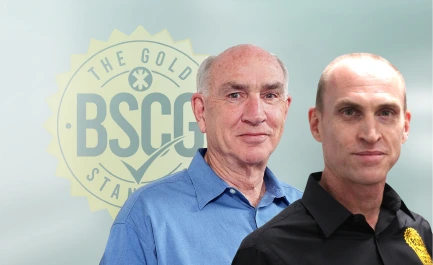
THE GOLD STANDARD IN THIRD-PARTY CERTIFICATION AND TESTING : +1-800-920-6605, info@bscg.org
The BSCG Dietary Supplement Ingredient Advisory List compiled below represents some of the items that have been sold as dietary supplements that do not appear to qualify as legal ingredients. We believe the ingredients listed here are investigational new drugs or may have been approved or explored as pharmaceutical drugs prior to being sold as supplements. BSCG does not accept any of the ingredients on this list as active ingredients in supplement products that we certify.
Athletes, military officers, first responders, and other drug-tested professionals should take note of this list, as the majority of the ingredients are also banned in sports and other fields where performance-enhancing drugs are prohibited. Substances not specifically listed as prohibited substances on the WADA Prohibited List or other similar banned substance lists should perhaps be added as they are often marketed as alternatives to substances specifically banned by name. We recommend that drug-tested athletes and professionals not use anything on the BSCG Dietary Supplement Ingredient Advisory List.
The opinions and information presented in the BSCG Dietary Supplement Ingredient Advisory List are those of BSCG and are provided publicly for informational purposes only. It is open for comment. To provide your insights or suggest the addition or removal of ingredients, please provide justification for doing so, and we will gladly consider it. The information was compiled with U.S. regulations in mind, dietary supplement regulations may vary internationally. The opinions and information summarized in the BSCG Dietary Supplement Ingredient Advisory List should not be construed as legal, regulatory, business, or compliance advice.
Please contact us to provide feedback or add your brand, organization, or name to our list of supporters below and join our effort to combat questionable dietary supplement ingredients.
High Performance Nutrition – Dr. Susan Kleiner, PhD, RD, FACN, CNS, FISSN

Ingredients that do not meet the Dietary Supplement Health and Education Act (DSHEA) definition of a dietary supplement should not be sold or labeled as supplements. We provide an excerpt of the definition below for reference.
Dietary Supplement“ (1) means a product (other than tobacco) intended to supplement the diet that bears or contains one or more of the following dietary ingredients:
It should be noted that some substances on the BSCG Dietary Supplement Ingredient Advisory List, particularly synthetic stimulants, may be naturally present in herbs or botanicals. Such presence in products used previously in cultural medicine or nutrition may make the ingredients permissible if that can be demonstrated. The definition above allows substances that may be present naturally in minute amounts to be concentrated and used as active ingredients as long as they weren’t explored as a drug previously. This is one of the most complex areas to consider in dietary supplement regulations. In some cases, a substance may be acceptable in the form of an extract but not in the form of a synthesized ingredient. We note such issues for certain ingredients in the list as relevant. We also include links to FDA warning letters that have been issued for the substances listed.
Some ingredients on the list may appear in the marketplace as “research chemicals,” which can be sold legally but not for human consumption. Once packaged and labeled as dietary supplements, or if suggested use guidelines are provided, the research chemical exemption is nullified and the products and ingredients would likely be considered to be adulterated with a new drug substance.
There are perhaps more than 40 SARMs in development currently as investigational new drugs. None have been approved as far as we know. Many have found their way into the dietary supplement market already or may in the future. We list the most common SARMs that appear today as dietary supplement ingredients. FDA SARMs Warning.
Growth hormone-releasing peptides (GHRPs) are drug substances designed to stimulate the release of human growth hormone in the body. Other peptides are designed to stimulate other human hormones, such as insulin growth factor -1 (IGF-1) and other related growth factors in the body. The FDA has issued warning letters to manufacturers of GHRPs.
DMAA – One of the original synthetic stimulants geranium oil extract was offered as the natural source of DMAA in an attempt to legitimize the ingredient. It quickly grew to include a variety of names and synonyms as outlined below. This ingredient became infamous in the Jack3D supplement. It should be noted that geranium and geranium oil are legitimate ingredients, while DMAA is not. The FDA began issuing warning letters in 2012.
Synthetic stimulant compounds are common pre-workout or fat-burner ingredients. Synthetic stimulants often attempt to appear compliant by connecting their origin to the plant kingdom. Ingredients that are constituents, extracts, or concentrates of plants or herbs can be considered legal supplement ingredients. The difficulty in this category is unraveling the truth behind the claims of natural origin. In some cases, a synthesized substance may not be interpreted as lawful, while the natural presence of the same substance in plant extracts may be legitimate. This subtle point is often difficult to manage in the course of ingredient regulations. Other times synthetic chemicals have been made that are nearly identical to natural compounds but synthetic modifications challenge their legitimacy as ingredients. We make a note of natural presence or synthetic mimetics in this category that may need to be considered further.
Aegeline – One of the early synthetic stimulants, this compound became infamous in OxyELITE Pro, which presented significant toxicity and adverse effects and received an FDA warning letter in 2013. A chemical rumored to come from the Bael Tree. The Bael tree is also known as Aegle marmelos, Arbre de Bael, Bael tree, Bel, Bel Indien, Bengal Quince, Bilva, Bilwa, Cognassier du Bengale, Coing du Bengale, Indian Bael, Manzana de Piedra, Membrillo de Bengala, Pomme du Bengale, Shivaphala, Stone Apple.
N-[2-hydroxy-2(4-methoxyphenyl) ethyl]-3-phenyl-2-propenamide
Bael tree extract
BMPEA – Acacia rigidula extract was rumored to be the natural source of this compound, but acacia can be toxic and was not considered a legitimate source. Other names for acacia rigidula are listed below. FDA BMPEA warning.
DEPEA – Dendrobium nobile, an orchid, was rumored to be a source of this ingredient, which became infamous in the Craze dietary supplement–which also contained DMPEA. The FDA issued a warning letter in 2014.
DMBA – The legitimate source of this compound was suggested to be Pouchong tea extract but recent science has suggested it is not present in the tea. This compound grew to include many names on supplement labels with Amperall and AMP Citrate becoming popular names. The FDA has been issuing warnings since 2015.
DMHA – Compound is reportedly present in Kigelia Africana fruit extract, which might make it legitimate if derived from the fruit. However, many Kigelia Africana fruit extracts on the market appear to derive from bark. Juglans regia is the English walnut tree. This compound is reportedly present in the bark, which was not in the food supply prior to 1994, so it is not considered a legitimate source. Juglans regia seeds, or walnuts, are legitimate ingredients and are not reported to contain this compound. The FDA has issued a number of warning letters on DMHA
DMPEA – Eria jarensis extract is suggested to be a natural source of this compound and extracts still commonly occur in commerce as dietary supplements. Acacia species also may contain this compound but due to potential toxicity of acacia extracts these are usually not considered legitimate sources. It was included in the Craze supplement as a component of dendrobium extract.
Higenamine – The synthetic chemical higenamine does not appear to be a legitimate ingredient. Natural extracts that contain higenamine may be legitimate; this should be considered further as many plants may contain this compound. Annona squamosa an African fruit is one such interesting source to consider. Higenamine is on the FDA Dietary Supplement Ingredient Advisory List.
Hordenine – The synthetic chemical hordenine is not a legitimate ingredient. However, hordenine is naturally present in cactus species, barley and other plants. Natural extracts of plants that contain hordenine may be legitimate, so this should be considered further. Hordenine is on the FDA Dietary Supplement Ingredient Advisory List.
Isopropyloctopamine – The synthetic chemical isopropyloctopamine does not appear to be a legitimate ingredient, the FDA denied a NDI application in 2004. It is described as being several times more powerful than synephrine and other amines like octopamine that can be naturally found in citrus extracts. Synephrine and octopamine may be present in small amounts in legitimate citrus extracts such as citrus aurantium or sinensis. However, these substances are prohibited in sport, and as a result athletes need to be careful with citrus extracts due to drug-testing concerns.
NMPEA – The synthetic chemical NMPEA does not appear to be a legitimate ingredient. That said, NMPEA is naturally present in humans and also present in apple, cabbage, and acacia species. It can be found at <10 ppm in many foodstuffs. The synthetic ingredient is not legitimate while low levels of natural presence is to be expected.
Orchilean – It is not clear what Orhilean is or whether it is present in Cymbidium goeringii extract as suggested. Orchilean may be similar to DEPEA, it was marketed as a replacement to DMAA. Cymbidium goeringii is a legitimate natural product used in essential oils.
Oxilofrine – The synthetic chemical oxilofrine does not appear to be a legitimate ingredient and is included in FDA warnings. The compound may be present in legitimate citrus extracts in relatively small amounts.
Phenethylamine HCl – Phenethylamine (PEA) is the parent of the phenethylamine class. The synthetic chemical PEA does not appear to be a legitimate ingredient. WADA and other sports leagues prohibit PEA and its derivatives. There are many derivatives, making this a complex regulation to consider. Phenethylamine itself may be naturally present in many legitimate supplement ingredients and extracts, including cactus, cocoa, blue-green algae (cyanobacteria), and more. It also appears as an active ingredient in supplements, which is the primary concern.
Nootropics, in general, are studied to potentially support cognitive function, alertness, mood, memory, and more. The category includes many legitimate natural products that should be distinguished from pharmaceutical nootropics that have been approved or studied as drugs. Many pharmaceutical nootropic ingredients sold as dietary supplements in Western countries have been approved as pharmaceutical drugs in Eastern Europe or Russia, where they are sold over the counter or by prescription, depending on the form. In the U.S., synthetic substances that have been investigated as drug products do not qualify as legal dietary supplement ingredients. It should be noted that some nootropics have reasonable safety profiles while others like tianeptine or phenibut may carry significant risks. Overuse or overdose can be problematic. Regulations vary around the world. For more information, you can explore this review of international regulations surrounding nootropics (we do not ensure the accuracy of the information nor do we endorse any products that may be mentioned). We thank alzforum.org for highlighting the concerns involved with pharmaceutical nootropics.

 YouTube Channel
YouTube Channel
Oliver Catlin Interview
 BSCG BLOG
BSCG BLOG
Tainted Supplements Still Causing NFL Doping Violations

 The Catlin Perspective blog widget
The Catlin Perspective blog widget
THE HISTORY OF BSCG